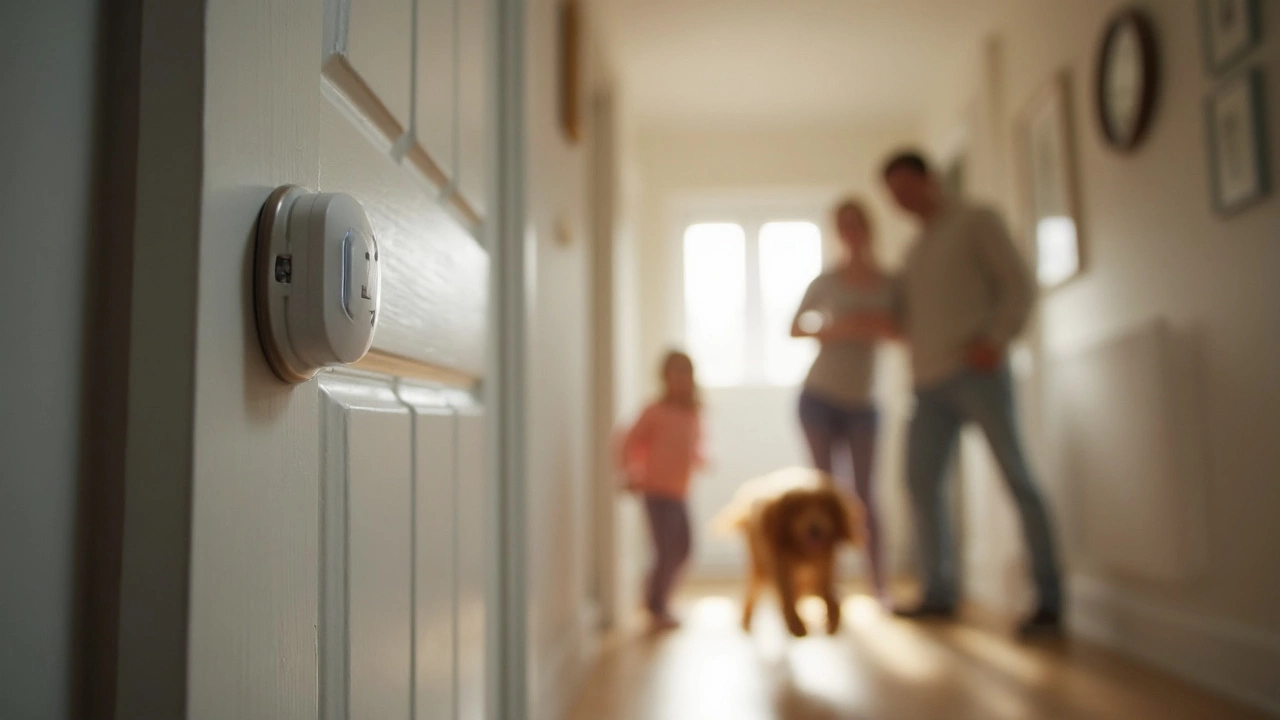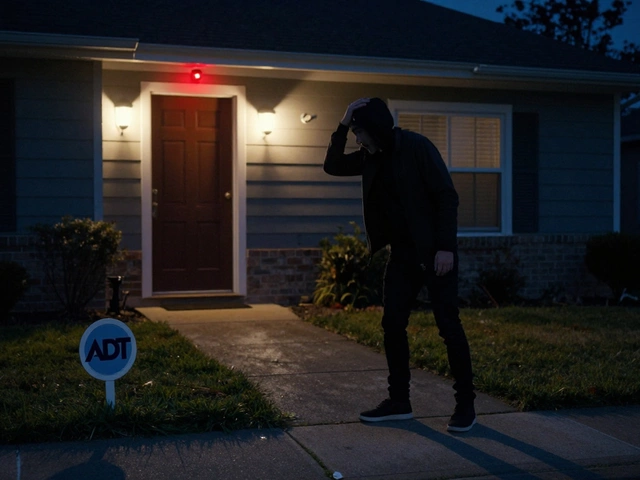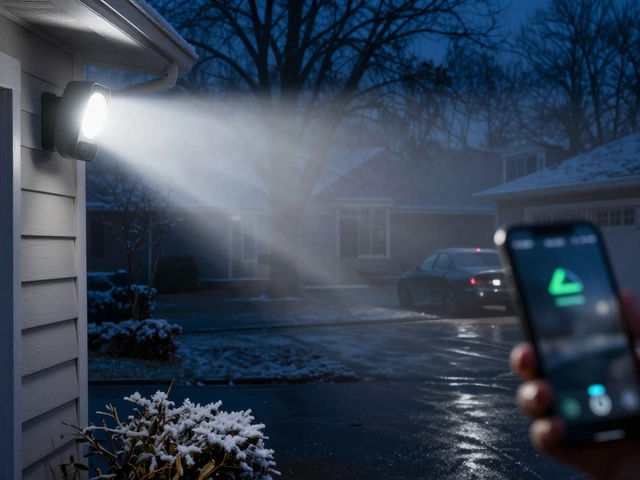Picture this: your dog is bouncing around the living room, and suddenly the security alarm goes off. Not exactly a chill way to spend your day, right? If you’ve got pets and are thinking about getting an ADT alarm—or maybe you already have one—you’re probably wondering how well these systems play with furry roommates.
Most ADT alarms come with motion sensors you can set up so your pets won’t accidentally trip them. These sensors are smart enough to ignore pets under a certain weight, usually around 40-50 pounds. So, cats and smaller dogs? No worries. If you’ve got a big, goofy retriever, though, you’ll want to know a few tricks to avoid chaos.
Some pet owners end up with non-stop false alarms just because they set the sensors at the wrong angle or in the wrong spot. Placement matters, and so does how you tinker with those sensitivity settings. A little know-how goes a long way to calm both your nerves and your pet.
- How ADT Alarms Work with Pets
- Pet Sensitivity in Motion Sensors
- Common Mistakes and Quick Fixes
- Best Tips for Pet Owners Using ADT Alarms
How ADT Alarms Work with Pets
ADT alarms have a pretty clever setup when it comes to handling pets. They use motion sensors that can tell the difference between a person and a pet by looking at heat and movement size. This means your 10-pound cat isn’t triggering the alarm every time they sprint through the living room.
Most ADT motion sensors are pet-immune up to about 40-50 pounds. If you’ve got a pet under that weight, the sensor just ignores them. It works by measuring things like infrared energy (how warm you are) and how tall an object is off the floor. The sensors are usually set about 6-8 feet high on the wall, which helps them spot adults but not pets sticking close to the ground.
This doesn’t just make your system smarter—it saves you from a bunch of false alarms, which can be annoying and also lead to fines in some cities. The idea is simple: It’s friendly enough for most families, whether you have a cat or a small to medium dog.
- If you’ve got big dogs, you might need to be careful. A Golden Retriever or Husky might weigh more than the default setting. You’ll want to talk with your installer to make sure the sensors are in spots where pets can’t jump up and set things off.
- The system doesn’t just rely on motion sensors; you can also use door and window sensors that are totally pet-proof, since most pets won’t open doors and windows. This lets you arm your house at night without worrying about your pets roaming inside.
- Setting the system to “stay” mode lets you keep the motion sensors off while everyone is home but keeps the perimeter sensors active. Perfect for when you and your pet are moving around inside.
If you want some data to feel confident, check out this table that shows typical pet sizes and motion detector limits:
| Pet Type | Average Weight (lbs) | ADT Pet Immunity Limit (lbs) |
|---|---|---|
| Cat | 8-15 | Up to 40-50 |
| Small Dog (e.g., Pug) | 15-25 | Up to 40-50 |
| Medium Dog (e.g., Border Collie) | 30-50 | Up to 40-50 |
| Large Dog (e.g., Golden Retriever) | 55-75+ | May trigger alarm |
So, if you’re working out your home security and you’ve got pets, focus on the ADT alarm specs. Make sure you match your pets’ sizes to what the system can handle. A quick call with an installer or a quick demo can go a long way here.
Pet Sensitivity in Motion Sensors
Here’s where things get interesting: ADT motion sensors aren’t all created equal when it comes to ignoring pets. Regular sensors will pick up movement no matter who or what’s walking by. But most ADT systems now come with “pet immune” or “pet-friendly” sensors that are built to skip over the family dog or cat.
How do they do it? These sensors use weight limits as the deciding factor. If your pet is under 40 or sometimes even 50 pounds, the sensor shouldn’t set off the alarm. But if you’ve got a couple of fluffy cats who like to jump together, their combined weight could cross the line. That’s why knowing your pets’ habits matters when placing these things.
Take a look at these typical sensitivity setups:
| Sensor Type | Pet Weight Limit | Notable Use |
|---|---|---|
| Standard Motion | None | No pet immunity; sensitive to all movement |
| Pet-Immune Motion | Up to 40 lbs | Great for cats or small/medium dogs |
| Advanced Pet-Immune Motion | Up to 60 lbs | Works for bigger dogs but not all breeds |
Here are a few straight-up facts to keep you from getting annoyed by false alarms:
- ADT’s ADT alarm motion detectors mostly use passive infrared (PIR) technology, which senses body heat and movement. They aim lower to avoid pets walking on the ground.
- Mount sensors 6-8 feet off the ground so they’re not picking up your pets but will still spot a person walking upright.
- If your pet likes to climb, stick to door or window sensors in those areas instead of relying on a motion sensor.
- Tweak settings. Most sensors let you adjust sensitivity in the app or at the device—great if your pets are on the edge of the weight cutoff.
According to ADT support stats from 2023, over 70% of false alarms in homes with pets came from owners who didn’t know about these setup tricks. So, a little setup goes a long way in keeping you headache-free.

Common Mistakes and Quick Fixes
The #1 mistake pet owners make with their ADT alarm setup? Installing motion sensors in spots where pets love to hang out—right by windows, on the couch, or anywhere your cat can leap. These high-traffic pet zones almost guarantee a false alert.
Another slip-up is forgetting to adjust the sensitivity on motion detectors. If you skip this step, even a small dog running by might set off the alarm. While many ADT sensors default to ignore pets under 50 pounds, don’t leave it to chance—check your sensor’s settings right away.
- Keep motion sensors at least four to five feet above the ground. If your dog jumps, bump it up a notch or choose a different spot.
- Avoid aiming sensors toward furniture your pets climb on. This one’s huge for cat owners, because cats are basically gymnasts. Try facing the sensor toward a wall or open floor area, not up a staircase or onto a window ledge.
- If your house has a big, energetic dog, use "pet-friendly" settings in the ADT app or ask your installer to adjust sensors while your dog is home, so they can see your pet’s real movements.
- Double-check batteries and clean the detectors every few months. Dust and hair can mess with readings, and a dead battery means your alarm won’t work when you need it.
If you’re getting endless alerts, don’t just unplug the motion sensor out of frustration. Test it out after re-positioning or turning down the sensitivity. In some cases, you might need to swap in a different type of sensor, like glass break or door contacts, for rooms where pets are always active.
Best Tips for Pet Owners Using ADT Alarms
Getting your ADT alarm set up for pets isn’t rocket science, but it pays to be smart. You can avoid 90% of false alarms just by placing sensors the right way and tweaking a few settings. Here’s the stuff pet owners need to know.
- Mount Sensors Above Pet Level: Position your motion sensors about 6-8 feet up and angle them away from furniture or places your pet might climb. Your home security company can do this for you if you ask during installation. If a cat jumps onto a tall shelf, that could still trip the sensor, so watch those spots.
- Use Pet-Immune Motion Sensors: Go for sensors built to ignore pets under 40 or 50 pounds. These are fairly standard with ADT. Check your user manual to see the specifics for your model.
- Limit Access in Armed Areas: If your pet can’t resist running wild, keep them out of rooms covered by sensitive sensors when the system is armed. Baby gates work wonders here.
- Test Before Using Regularly: After setup, arm your system and watch how your pet moves. Trigger a few fake alarms if you have to. This shows you where tweaks are needed, so your phone isn’t blowing up when your cat darts across the hallway at 3am.
- Adjust the Sensitivity: Most ADT systems let you set how sensitive the sensors are. If you’re getting false alarms, try lowering the sensitivity a notch. If you aren’t sure how, the ADT help line or app walks you through it.
If you want the numbers, check out this quick table:
| Sensor Type | Pet Weight Tolerance | Common Placement |
|---|---|---|
| Standard Motion | Up to 40 lbs | 6-8 ft high, avoid stairs |
| Advanced Pet-Immune | Up to 80 lbs | Walls, corners (away from shelves) |
One last tip: Keep your monitoring contacts up to date. If a false alarm does happen, the right person gets notified, not your old roommate from three years ago. With a little planning, even excited pups or curious cats won’t mess with your security game.






